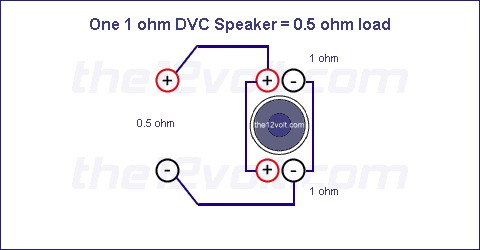Wiring a subwoofer can seem daunting, especially when dealing with dual voice coil (DVC) speakers and impedance matching. A solid understanding of 1 Ohm Wiring Diagrams is crucial for optimal performance and to avoid damaging your equipment. This article will break down the complexities of wiring a 1 ohm DVC subwoofer, ensuring you get the most out of your car audio system.
Wiring Options for a 1 Ohm DVC Subwoofer
A dual voice coil subwoofer offers flexibility in wiring configurations, allowing you to achieve different impedance loads. With a 1 ohm DVC subwoofer, you have two primary wiring options: parallel and series. Each configuration results in a different final impedance load, impacting the power output and compatibility with your amplifier.
Parallel Wiring for 0.5 Ohm Load
In a parallel wiring configuration, the positive terminals of both voice coils are connected, and the negative terminals are connected. This effectively halves the impedance, resulting in a 0.5 ohm load.
Important Considerations: A 0.5 ohm load demands a powerful amplifier specifically designed to handle such low impedance. Verify your amplifier’s specifications before using this configuration, as an incompatible amplifier can lead to overheating and damage.
Series Wiring for 2 Ohm Load
Series wiring involves connecting the positive terminal of one voice coil to the negative terminal of the other. The remaining positive and negative terminals are then connected to the amplifier. This configuration doubles the impedance, resulting in a 2 ohm load.
Important Considerations: A 2 ohm load is generally more compatible with a wider range of amplifiers. While this configuration might not deliver the maximum power output potential of the subwoofer, it offers a safer and more stable setup for many systems.
Choosing the Right Amplifier for Your 1 Ohm Wiring Diagram
Before connecting your subwoofer, consult your amplifier’s owner’s manual to confirm its minimum impedance rating. Using an amplifier not rated for the final impedance of your chosen wiring configuration can result in damage to both the amplifier and the subwoofer. For a 0.5 ohm load, you’ll need an amplifier stable at 1/2 ohm mono. For a 2 ohm load, an amplifier stable at 2 or 1 ohm mono is recommended.
Ensuring Proper Polarity
Maintaining proper polarity is paramount to prevent damage to your equipment. Incorrect polarity can lead to phase cancellation and reduced sound quality. When wiring your subwoofer, double-check all connections to ensure the positive (+) and negative (-) terminals are correctly aligned. Note that in some diagrams, the positive and negative terminals may be reversed for clarity. Always refer to the actual wiring on your subwoofer and amplifier.
Conclusion
Understanding 1 ohm wiring diagrams is essential for correctly connecting a DVC subwoofer and maximizing its performance. Carefully consider your amplifier’s capabilities and choose the wiring configuration that best matches its impedance rating. Always double-check your connections and observe proper polarity to avoid damaging your equipment. With the right wiring, you can enjoy deep, powerful bass that enhances your car audio experience.

